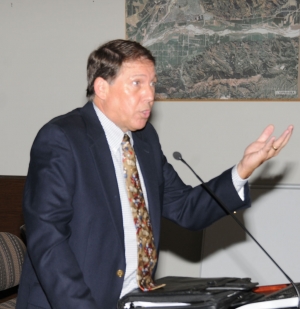|
Council addressing low income housing unit elements
 By Jean McLeod — Wednesday, September 11th, 2013
 Housing Consultant Tom Figg is working with Community Development Director Kevin McSweeney to examine and resolve the City’s Housing Element problem. The September 10, 2013 Fillmore City Council Meeting centrally focused on two important items for the residents of Fillmore; transportation and housing. Other items discussed were Fillmore’s investment policy and payment obligations. Fillmore has contracted with Kevin McSweeney as Interim Community Development Director along with Housing Consultant Tom Figg, who has over 30 years experience in housing and community development working throughout Southern California and many towns in Ventura County, to examine and resolve the City’s Housing Element problem. The General Plan identifies that 5,816 residential units are planned for the City which will result in a population of 22,693 by the year 2020. There are currently 4,408 residential units in the City. Therefore, through the General Plan, the City of Fillmore has planned for the remaining 1,408 residential units for the year 2020. The required units have designated income levels that RHNA identifies as 160 very low income units and 112 as low income units resulting in 272 low income units that need to be planned for during the 2014-2021 Housing Element period. But, there are past low income unit requirements that have not been met. Because the City did not complete the General Plan Amendments to address some of the low income units as described in the last Housing Elements periods, those units were rolled over into the new Housing Element period. Those units are called “unaccommodated need.” This represents 244 units from previous Housing Element periods that will be added to the proposed RHNA low income units bringing this Housing Element period to require a total of 1,455 units which includes very low, lower, moderate and other housing units for the years 2014-2020. In previous talks with California Housing and Community Development McSweeney said they were pleased with Fillmore’s effort to increase housing density downtown that amended the Downtown Specific Plan from 15 to 50 units per acre, but that does not change the required low income units. At that time Councilmember Steve Conaway reminded those council members (not the present council) that they lowered the density of the North Fillmore Specific Plan Development, which lowered the low income units available and created some of the unaccommodated need the Council is dealing with today and that now those low income units must be accounted for in other areas of the City. A Revision Request in 2012 (asking that the number of units be lowered) was submitted but denied. Besides the Housing Element addressing the financial needs of lower income residents it also addresses future growth. A town’s future growth rate is determined by such basic traits as its climate, location, topography, natural resources and investment. Fillmore has abundance of favorable characteristics that could continue to draw people. As Fillmore’s population expands those responsible for making decisions must address the needs of the present without compromising the ability of future generations to meet their own needs. The challenge to the city planners and city councils is to invest wisely and sufficiently to accommodate growth and development, and not prevent it which is one of the goals of the Housing Element. Fillmore’s ability to coordinate growth and infrastructure will determine how the City consumes its limited resources, whether it’s housing, business, open space, water, or even roadway capacity. The 2012 Council Members were willing to consider the idea of copying Ventura’s amnesty on non-conforming units, often called Granny Flats. That idea was not followed through with when those working in the Planning Department were laid-off and the idea was dropped. Ventura counted those Granny Flat units to meet its housing requirements. When asked, McSweeney said presently they will explore many ideas and avenues to meet the present obligations. Figg addressed the Council with the growing Housing Element requirements with the first of many presentations in a workshop He explained how the Housing Element is determined; which focuses on income, costs to buy and rent, special populations, overcrowding and substandard conditions. Another item on the agenda was the Joint Powers Agreement (JPA) which will become a jointly operated transportation system with the County of Ventura, the City of Santa Paula and Fillmore with each jurisdiction having one vote. The JPA will allow a retained local control over transit service in the Heritage Valley, administrative decision making and funding for the expanded service. There is a time restraint in implementing the new service and retain continuity of service after July 1, 2014. The proposal is to have fixed routes and will be encouraging ridership to switch from Dial-A-Ride (DAR) to the new fixed routes that are time scheduled. The choice of fixed routes will be determined by community input, examination of performance data, public surveys and demographic data. ADA accommodation is mandatory when fixed routes are in place. Presently DAR is overwhelmed and not meeting the needs of those relying on it. The exact routes of pickup and drop-off must be decided on by the late October to early November and there is a five year sunset clause to reexamine the system. |
